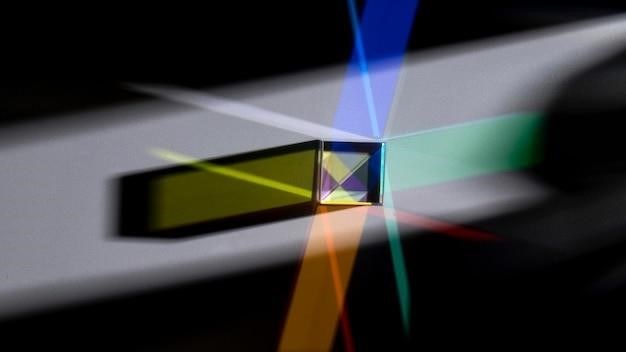
CAPM Study Guide PDF⁚ A Comprehensive Guide
The CAPM (Certified Associate in Project Management) exam is a globally recognized certification that demonstrates your understanding of project management principles and practices. Passing the CAPM exam can open doors to new career opportunities, enhance your credibility, and increase your earning potential. This comprehensive guide will provide you with everything you need to know about the CAPM exam, including study resources, effective study strategies, and exam day tips.
Introduction
The CAPM (Certified Associate in Project Management) exam is a globally recognized certification that demonstrates your understanding of project management principles and practices. It is a stepping stone for aspiring project managers, providing a foundational understanding of the project management methodology. The CAPM certification is offered by the Project Management Institute (PMI), a globally recognized professional organization for project management. Obtaining this certification can be a valuable asset in your career, opening doors to new opportunities and enhancing your credibility. The CAPM exam covers a broad range of project management topics, including project initiation, planning, execution, monitoring and controlling, and closure. It is designed to assess your ability to apply project management knowledge and skills in real-world scenarios. This comprehensive guide will provide you with everything you need to know about the CAPM exam, including study resources, effective study strategies, and exam day tips.
Importance of the CAPM Certification
The CAPM certification is a valuable asset for individuals seeking to advance their careers in project management. It demonstrates a foundational understanding of project management principles and practices, making you a more attractive candidate for employers. Holding the CAPM certification can lead to increased earning potential, as employers often recognize and reward certified professionals. Additionally, the certification enhances your credibility and professionalism, showcasing your commitment to professional development in the field. By demonstrating your knowledge and skills, the CAPM certification can help you stand out from the competition and open doors to new opportunities. The certification can also provide a stepping stone towards more advanced project management certifications, such as the PMP (Project Management Professional) certification, which can further enhance your career prospects.
CAPM Exam Overview
The CAPM exam is a multiple-choice, computer-based exam that assesses your understanding of project management principles and practices. It consists of 150 questions, with a passing score of 80%. The exam is designed to evaluate your knowledge of the PMBOK Guide (Project Management Body of Knowledge) and its application to real-world project scenarios. The exam is offered in English and several other languages, and you can take it at a Pearson VUE testing center worldwide. The exam duration is three hours, including a 15-minute tutorial and a short break. To be eligible to take the CAPM exam, you must have a high school diploma or equivalent and at least 1,500 hours of project management experience or 23 hours of project management education. The CAPM certification is valid for five years, and you can renew it by earning 60 Professional Development Units (PDUs) during that period. The CAPM exam is a challenging but rewarding experience that can significantly benefit your career in project management.
Key Areas Covered in the CAPM Exam
The CAPM exam covers a wide range of project management knowledge areas, encompassing both the processes and principles of project management. The exam content outline is divided into five domains, each with its own set of topics and weighting. The five domains are⁚ Project Integration Management, Project Scope Management, Project Schedule Management, Project Cost Management, Project Quality Management, Project Resource Management, Project Communications Management, Project Risk Management, Project Procurement Management, and Project Stakeholder Management; The exam questions are designed to assess your understanding of these key areas, as well as your ability to apply them in real-world project scenarios. By focusing your studies on these key areas, you can increase your chances of success on the CAPM exam.
Project Management Processes
The CAPM exam emphasizes understanding the project management processes outlined in the PMBOK® Guide. These processes are grouped into ten knowledge areas, each representing a distinct aspect of project management. The processes are interconnected and form a framework for managing projects effectively. Each process involves specific inputs, tools and techniques, and outputs that contribute to the overall project success. A thorough understanding of these processes is crucial for passing the CAPM exam and demonstrating your ability to apply them in real-world projects. The PMBOK® Guide provides comprehensive information on each process, including its definition, purpose, and key elements.
Project Management Knowledge Areas
The CAPM exam covers ten project management knowledge areas, each representing a critical aspect of project management. These knowledge areas are interconnected and provide a framework for managing projects effectively. They include⁚ Integration Management, Scope Management, Schedule Management, Cost Management, Quality Management, Resource Management, Communications Management, Risk Management, Procurement Management, and Stakeholder Management. Understanding these knowledge areas is essential for passing the CAPM exam and demonstrates your ability to apply them in real-world projects. The PMBOK® Guide provides detailed information on each knowledge area, including its definition, key processes, and tools and techniques.
Best CAPM Study Resources
Preparing for the CAPM exam requires a strategic approach and access to reliable study resources. There are numerous resources available to help you prepare effectively, each offering unique benefits. These resources can be categorized into several types, including CAPM study guide PDFs, online courses and bootcamps, practice exams, and study groups and mentorship. By utilizing a combination of these resources, you can create a comprehensive study plan that caters to your learning style and helps you master the required knowledge and skills for success on the CAPM exam.
CAPM Study Guide PDFs
CAPM study guide PDFs are readily available online and offer a structured approach to understanding the CAPM exam content. These guides typically cover the key areas of the exam, including project management processes, knowledge areas, and tools and techniques. They provide concise explanations, examples, and practice questions to reinforce your learning. The PDFs often include chapter summaries, glossary terms, and practice tests to help you assess your understanding. When choosing a CAPM study guide PDF, consider the author’s expertise, the guide’s comprehensiveness, and the inclusion of updated information aligned with the latest exam content. Look for guides that are well-organized, easy to read, and provide clear explanations of complex concepts.
Online Courses and Bootcamps
Online courses and bootcamps provide a structured and interactive learning experience for CAPM exam preparation. These platforms offer a comprehensive curriculum, engaging video lectures, interactive exercises, and practice exams. They often include expert instructors who can provide guidance and answer your questions. Online courses and bootcamps are particularly beneficial for individuals who prefer a flexible learning environment and enjoy interactive learning methods. They can also help you stay motivated and on track with your studies. When choosing an online course or bootcamp, look for reputable providers with experienced instructors, a comprehensive curriculum, and positive student reviews. Consider the platform’s features, such as the availability of live sessions, personalized feedback, and access to study materials.
Practice Exams
Practice exams are an essential part of CAPM exam preparation; They allow you to assess your understanding of the exam content, identify your strengths and weaknesses, and familiarize yourself with the exam format and timing. There are numerous online resources and study guides that offer practice exams for the CAPM certification. These practice exams are designed to simulate the real exam experience, providing you with valuable feedback and insights. When choosing practice exams, look for those that are comprehensive, up-to-date, and aligned with the latest exam syllabus. Consider the number of practice exams offered, the difficulty level, and the availability of detailed explanations for correct and incorrect answers. Regular practice exams can help you build confidence, improve your time management skills, and increase your chances of success on the actual CAPM exam.
Study Groups and Mentorship
Joining a study group or seeking mentorship can significantly enhance your CAPM exam preparation. Study groups provide a collaborative learning environment where you can discuss challenging concepts, share study materials, and motivate each other. Mentorship offers personalized guidance and support from experienced project managers who have already passed the CAPM exam. They can offer valuable insights, answer your questions, and provide feedback on your progress. Look for study groups and mentorship programs offered by PMI chapters, online platforms, or professional organizations. When choosing a study group or mentor, ensure they have a strong understanding of the CAPM exam content, a proven track record of success, and a commitment to helping you achieve your goals. The support and guidance you receive from study groups and mentors can make a significant difference in your journey to passing the CAPM exam.
Effective Study Strategies
To maximize your chances of success on the CAPM exam, it’s crucial to adopt effective study strategies. Start by creating a study plan that outlines your goals, timelines, and learning objectives. Break down the exam content into manageable sections and allocate sufficient time for each area. Employ active learning techniques such as summarizing key concepts, creating flashcards, and practicing mock exams. Engage in regular review sessions to reinforce your learning and identify any knowledge gaps. Don’t hesitate to seek clarification from your study materials or a mentor if you encounter any challenging topics. Remember, consistency is key. Dedicate consistent time to studying, even if it’s just for short intervals, to build momentum and retain information effectively. By following these strategies, you can ensure you are well-prepared to tackle the CAPM exam with confidence.
Time Management and Planning
Time management is crucial for effective CAPM exam preparation. Create a realistic study schedule that takes into account your work commitments, personal obligations, and the time required to cover the exam syllabus. Allocate specific time slots for studying and adhere to your schedule as much as possible. Break down the exam content into smaller, manageable chunks, and set achievable daily or weekly goals. This approach helps prevent overwhelm and fosters a sense of accomplishment. Prioritize topics based on their weight in the exam and your personal strengths and weaknesses. Don’t wait until the last minute to start studying; a well-planned and consistent approach will lead to better understanding and retention of the material.
Active Learning Techniques
Passive reading or simply listening to lectures is not enough to truly understand and retain the vast amount of information required for the CAPM exam. Embrace active learning techniques to enhance your comprehension and memory. Take notes while reading study materials or attending online courses; this encourages active engagement and helps you identify key concepts. Summarize chapters, create flashcards, or use mind maps to organize and visualize complex information. Test yourself regularly with practice questions and analyze your performance to identify areas requiring further study. Join study groups or online forums to discuss concepts with peers, which fosters deeper understanding and retention. Active learning techniques transform you from a passive receiver of information to an active participant in the learning process, leading to better exam preparation.
Practice, Practice, Practice
The saying “practice makes perfect” holds true for the CAPM exam. Repeatedly exposing yourself to exam-style questions is crucial for familiarizing yourself with the format, content, and difficulty level of the exam. Numerous resources offer practice exams, including online platforms, study guides, and official PMI materials. Take advantage of these resources to simulate the real exam experience and identify your strengths and weaknesses. Analyze your performance on practice exams, focusing on the areas where you struggle. Revisit the relevant study materials, practice additional questions, and seek clarification on any concepts you find challenging. Regular practice not only builds your confidence but also helps you develop time management skills and adapt to the exam environment.
Passing the CAPM Exam
After dedicated preparation, you’re ready to take the CAPM exam. The exam is a computer-based, multiple-choice test, typically consisting of 150 questions covering the five project management process groups and ten knowledge areas. The passing score is determined by PMI, and you’ll receive your results within a few weeks. While the exam can be challenging, your preparation and commitment will pay off. Remember to stay calm, read each question carefully, and eliminate incorrect answers. Trust your instincts and choose the best option based on your understanding of project management principles. After the exam, take a well-deserved break and await the results. Congratulations on completing this significant milestone in your project management journey!
Exam Day Tips
On exam day, it’s crucial to arrive at the testing center well-prepared and relaxed. Bring your official ID, confirmation email, and any necessary materials. Familiarize yourself with the exam format, including the types of questions and time limits. Take a few deep breaths to calm your nerves and focus on the task ahead. During the exam, read each question carefully and eliminate incorrect answers. Don’t overthink it; trust your instincts and choose the best option. If you’re unsure about an answer, mark it for review and come back to it later. Pace yourself and allocate sufficient time for each section. Remember to take short breaks throughout the exam to maintain focus and avoid fatigue. After completing the exam, review your answers and ensure you’ve answered all the questions. Then, submit your exam and await the results.
After the Exam
Once you’ve completed the CAPM exam, you’ll receive your results within a few weeks. If you’ve passed, congratulations! You’ve achieved a valuable credential that demonstrates your project management knowledge and skills. If you didn’t pass, don’t be discouraged. Analyze your results to identify areas where you need improvement. Consider taking a review course or studying additional materials to strengthen your understanding. You can retake the exam after a specified waiting period. Remember, persistence and dedication are key to success. After passing the CAPM exam, consider joining a professional project management organization like PMI (Project Management Institute). This will provide you with valuable networking opportunities, access to industry resources, and ongoing professional development. Your CAPM certification is a stepping stone to a successful career in project management. Continue to learn and grow your expertise, and you’ll be well-equipped to tackle any project challenges that come your way.

The CAPM certification is a valuable asset for anyone aspiring to a career in project management. It demonstrates a foundational understanding of project management principles and practices, opening doors to new career opportunities, increased earning potential, and enhanced credibility within the industry. While the journey to obtaining the CAPM certification may require dedication and effort, the rewards are well worth it. By utilizing effective study strategies, leveraging available resources, and embracing the learning process, you can confidently prepare for the CAPM exam and achieve your professional goals. Remember, the CAPM certification is just the beginning. Continue to develop your skills, stay updated on industry trends, and actively contribute to the project management community. Your commitment to continuous learning will ensure a fulfilling and successful career in this dynamic field.

















